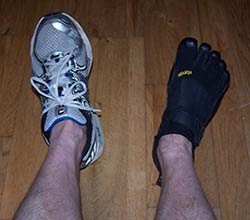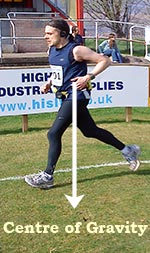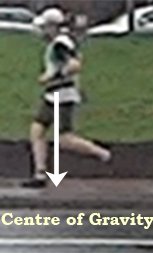Finally, A Minimalist Running Transition Program...!
Thinking about making the switch to Minimalist Running?
... and how to make the transition safely?
Well, look no further :-)

The aim of this page is to help you make the transition to a minimalist shoe using a weekly running program – and the good news is, you don’t even have to reduce your weekly mileage!
You can start the program from scratch or incorporate it into an existing schedule, it’s up to you
Be aware though, the transition to a minimalist shoe takes patience. The new impact forces applied to your bones and muscles means they need time to strengthen and adapt. A common mistake is to replace existing shoes with a minimal pair and carry on running as normal – this is the reason why injuries are associated with minimalist running
The best idea is to carry on running in your old shoes and introduce small “minimalist intervals” into your runs – this way you maintain fitness but at the same time you make a slow transition
Running Tips HQ:
Run with a backpack so you can carry your new shoes with you - then you can pop them on and off whenever you are ready
Ideally, warm up for a mile in your old shoes before running in minimalist shoes
Run minimalist only 3 days a week and on alternate days (never run 2 consecutive days). This is important for recovery/adaptation
Every runner is different and some will adapt more quickly than others, so think of the transition program as a minimum requirement - don’t be tempted to skip weeks because the progression seems too slow – it needs to be that way ;-)
But if you need to take longer to complete the program, please feel free - in fact I would invite you to repeat a week or go back a week whenever you see fit
Minimalist Running Transition Program
Include the following minimalist intervals into your schedule, starting off with 1 mile and gradually increasing 1/8 mile every other run (0.13 mile). By week 6 the increments are ¼ mile
| Week | Run 1 | Run 2 | Run 3 | Week | Run 1 | Run 2 | Run 3 |
| 1 | 1 mile | 1.13 | 1.13 | 11 | 3.75 | 4 | 4 |
| 2 | 1.25 | 1.25 | 1.38 | 12 | 4.25 | 4.25 | 4.5 |
| 3 | 1.38 | 1.5 | 1.5 | 13 | 4.5 | 4.75 | 4.75 |
| 4 | 1.63 | 1.63 | 1.75 | 14 | 5 | 5 | 5.25 |
| 5 | 1.75 | 1.88 | 1.88 | 15 | 5.25 | 5.5 | 5.5 |
| 6 | 2 | 2 | 2.25 | 16 | 5.75 | 5.75 | 6 |
| 7 | 2.25 | 2.5 | 2.5 | 17 | 6 | 6.25 | 6.5 |
| 8 | 2.75 | 2.75 | 3 | 18 | 6.5 | 6.75 | 7 |
| 9 | 3 | 3.25 | 3.25 | 19 | 7 | 7.25 | 7.5 |
| 10 | 3.5 | 3.5 | 3.75 | 20 | 7.5 | 7.75 | 8 |
Beginner Runners
Provided you can run a mile, there’s no reason why you can’t follow this program from beginning to end. However, If you think 8 miles is a big target just shorten the program to Week 8 / 3 miles, or Week 16 / 6 miles
As a raw beginner (not ran a mile for a while?) start off with the Couch to 5K walk/run program instead. Start and finish the program in minimalist footwear as this is a perfect approach for novice runners (click here)
Experienced Runners
There are 3 approaches to this program I would recommend:
- Drop any targets you have and reduce your mileage to about 15-20 miles a week. This way you can really focus on the minimalist training. For example, run 3 days a week, 5-7 miles per run and incorporate the minimalist intervals as above
- If you run more than 25 miles a week (seasoned marathoner or ultra runner?) and you want to make the transition while training, that’s OK; just include the minimalist intervals into 3 of your runs per week – dead easy ;-)
- Of course, another approach is to start the Minimalist Running Transition Program from scratch, leaving your old shoes at home. You will lose fitness this way, but you could do some cross training to keep your fitness levels up while your running mileage returns to normal
These are just my own ideas, if you can see another way of including the program into your routine just go for it!
Side effects:
- Pain on top of the foot – this should be nothing more than a mild ache and is normal
- The Achilles tendon – this gets shortened when we wear built up heels and you may feel a stretch when wearing minimalist running shoes, so might ache a little
- Your calf muscles work differently when running minimalist so expect some tenderness and mild pain
Note: Aches and pains come and go, but if pains persist for more than a day go back a week in the program – or, try reducing your mileage by 50%. See the doctor if you are in any doubt
A final point: as you make progress with the program stay away from speed work. Much of the anecdotal evidence has shown that when injuries have occurred it is often because runners tried running faster before they were ready, putting more strain on the metatarsals and causing a stress injury
Complete the program before thinking about faster times, you know it makes sense ;-)
What happens when I finish..?
OK, once you reach the end of the program by all means take things into your own hands:
- Increase weekly mileage by 10% (or less)
- When you want to increase speed start off with gradual tempo and/or interval runs
- Don’t increase your distance and speed at the same time
Then you are all done!
My own experience
The key benefit has been to my running form
For years I was a heel striker (with over-stride) and I had tried different methods of correcting it but, in the long-term, I found nothing that worked

- I read that conventional running shoes might be the source of my problem, i.e. runners typically over-stride when wearing padded shoes because of the added protection on the heel
This grabbed my attention and so I made a decision:
First, I made a transition to running barefoot (2 miles), then I continued my transition in Vibram KSO’s.Then, by using video footage, I confirmed that my form had improved after 4 weeks
The main thing was that my over-stride had gone and I landed with a vertical lower leg (see image below)

(Compare this with the one above it)
Because there was no over-stride this meant that I no longer landed on the back of my heel, in fact I landed on my forefoot – HAH, result!
Going from a padded shoe to a minimalist running shoe meant that I could better feel the ground I was running on - this, in turn allowed my body to respond and run with better form…
Something I had been trying to do for years, now just happened automatically – no coaching, no DVD’s, just a pair of floppy KSO’s and my bare feet! Think minimalist running, it pays.
It took 12 months to get to the stage where my long run was 15 miles in the KSO’s and 6 miles barefoot. I ran slower, but found I was more relaxed and enjoying my running more.
So be patient folks – the journey to minimalist running might be a long one, but probably worth your wait in gold!
Have fun!
To return from the Minimalist Running page back to the homepage, click here
